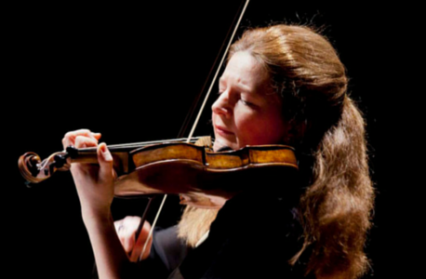The Riverfront, Newport, May 31 2015
J.S. Bach: Suite No 3 in D Major, BWV 1068
Purcell: Suite from The Faerie Queen
J.S. Bach: Violin Concerto in A Minor, BWV 1041
J.J.Fux: Overture in G Minor, K 355
Vivaldi: Concerto No. 10 from L’Estro Armonico, Op. 3
Telemann: Concerto in D Major TWV 53: D5
Sinfonia Cymru
Violin and Guest Director: Rachel Podger
When the history of Sinfonia Cymru is ready to be written, much will have to be made of how leading musicians of the day threw in their lot with the orchestra and discovered how good it was – and how undiminished they looked and sounded in its company. The decision of Bryn Terfel, Llŷr Williams, Benjamin Grosvenor, Paul Watkins, Catrin Finch, Carlo Rizzi and many others to perform with it is one of the most important developments in a story of continuing change and renewal. It’s an orchestra now settled in its personnel, and facing busy schedules, but still with the accent on young adult musicians in the early stages of a professional career.
As far as this Welsh contingent is concerned – and that includes sometime guest conductor Rizzi as a Welshman by adoption – no-one should suspect that wishing to further the orchestra’s ambitions were entirely a result of patriotic sympathies. Few who heard it will forget Rizzi’s confession to an audience a few years back after conducting a concert in Cardiff involving the young that there was nothing to compare with youth music-making in Wales, not even in his native Italy. Sudden deep breaths were drawn by people sitting back in amazement. Perhaps there’s something in the air at Cardiff Bay, where the orchestra first began in the 1990s under founding-father Gareth Jones.
Fluidity, once a characteristic of its newly-graduated, upwardly-mobile members, is now focused on repertoire; the core of which is chamber music, Sinfonia Cymru being essentially a chamber orchestra but also capable of expansion and contraction. For its May tour to Llanelli, Cardiff and Newport, the legendary and award-winning violinist Rachel Podger was invited to direct and perform in its first all-Baroque concert. Podger, leader of the Brecon Baroque and a frequently-recorded solo fiddler, lives in Brecon and is artistic director of her own festival there. But geographical proximity to where Sinfonia Cymru operates was not the only reason that attracted her to the engagement: she’d also been impressed by the reviews of its concerts and kindred activities. Sinfonia Cymru is an orchestra with a reputation as well as an ethos.
If you’re to work with a specialist in 18th-century music you can expect to make changes. So-called ‘period’ music, the kind we all thought we knew but didn’t, has followed a path similar to the political volte-face: a revolution, followed by a dictatorship, followed by an empire, each, bar the second, more or less benign in the musical context and denoting sudden enlightenment and spreading popularity. The problem is that no-one can say for sure how music sounded beyond living memory or before recording, hence the less benign character of those who think they do and countenance nothing less than what they say as authentic. On this showing, Podger is not of their number, her vivacity everywhere trumping any claim to authenticity, and proving that bounty can result from unpredicated method, energy and insight without all the physical materials one might wish for in an ideal Baroque setting.
That’s because important but not exclusive concessions were made, here, to the Baroque. There were Baroque drums, bright piccolo trumpets, specialist bows, some gut strings, little or no string vibrato and everyone bar the harpsichordist standing to play. Podger began as she intended to proceed in the Overture to Bach’s Suite No 3, persuading everyone to duck and dive contrapuntally as they brought dynamics to bear on lines that as a result surged then drew back, before everything settled into the famous Air, which derived from the lively motion of the opening in being reduced to a song given out andante rather than as a funereal dirge; we get enough of those but we got this more animated Air as an encore too. Trumpets and drums were not the only matters dispensed with in Purcell’s The Faerie Queen Suite as High Baroque gave way to Early, Podger’s take much lighter and appropriately theatrical and terpsichoreal, a mood that largely carried over into Bach’s Violin Concerto in A Minor, in which she was a sometimes preoccupied soloist, but presumably by then having established faith in everyone to keep things in the kind of motion she was insisting on.
All were certainly motoring when Vivaldi’s Concerto No 10 from L’Estro Armonico was reached via Fux’s Overture in G minor with its perky woodwind trios (the modern oboes clean and keen but not as bitingly incisive as their Baroque counterparts) and its stately features. The Vivaldi violin soloists were Podger, Caroline Pether, Kirsty Lovie and Simmy Singh, all acutely expressive and inter-disciplinary but only as concertante instruments encouraged by an ever-sharp and aurally demarcated ripieno. So confident was everyone towards the end that trumpeter Jason Lewis in Telemann’s Concerto in D allowed himself an octave leap that sounded as though it might not have been in the score. The trumpet shall sound with bravura – and it did. If it isn’t in the score, it should have been. Is there anything this orchestra cannot achieve?



 Enjoyed this article? Support our writers directly by buying them a coffee and clicking this link.
Enjoyed this article? Support our writers directly by buying them a coffee and clicking this link.







